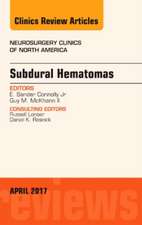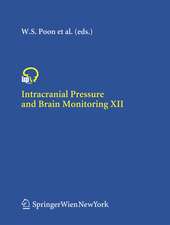Neurochemical Monitoring in the Intensive Care Unit: Microdialysis, Jugular Venous Oximetry, and Near-Infrared Spectroscopy, Proceedings of the 1st International Symposium on Neurochemical Monitoring in the ICU held concurrently with the 5th Biannual Conference of the Japanese Study Group of Cerebral Venous Oximetry in Tokyo, Japan, May 2021, 1994
Editat de Takashi Tsubokawa, Anthony Marmarou, Claudia Robertson, Graham Teasdaleen Limba Engleză Paperback – 18 apr 2012
Preț: 366.91 lei
Preț vechi: 386.22 lei
-5% Nou
Puncte Express: 550
Preț estimativ în valută:
70.23€ • 72.37$ • 59.29£
70.23€ • 72.37$ • 59.29£
Carte tipărită la comandă
Livrare economică 03-17 martie
Preluare comenzi: 021 569.72.76
Specificații
ISBN-13: 9784431685241
ISBN-10: 4431685243
Pagini: 264
Ilustrații: XIX, 240 p.
Dimensiuni: 155 x 235 x 14 mm
Greutate: 0.37 kg
Ediția:Softcover reprint of the original 1st ed. 1995
Editura: Springer
Colecția Springer
Locul publicării:Tokyo, Japan
ISBN-10: 4431685243
Pagini: 264
Ilustrații: XIX, 240 p.
Dimensiuni: 155 x 235 x 14 mm
Greutate: 0.37 kg
Ediția:Softcover reprint of the original 1st ed. 1995
Editura: Springer
Colecția Springer
Locul publicării:Tokyo, Japan
Public țintă
ResearchDescriere
Neurophysiological recording is the major neuromonitoring technique employed in ICU. In addition, continuous recording of intracranial pressure has proved to provide infomation useful for critical care of the patient with severe brain damage. It is, however, difficult to assess neurochemical and/or metabolic environments of the brain with these conventional neuromoni toring techniques. Information regarding these changes, if available on a real-time basis, is undoubtedly useful for patient care. Many important developments in bedside techniques to monitor these changes have been achieved during the last few years. It was the consensus of the editors that a symposium to exchange knowledge concerning recent advances in such techniques would be valuable. With this background, the First International Symposium of Neuro chemical Monitoring in ICU held May 20-21, 1994, in Tokyo, Japan. It was not the intention of the organizers that this symposium should survey the whole field of neuromonitoring in ICU. The symposium was thus focused on clinical application of microdialysis, jugular venous oximetry, and near infrared spectroscopy, which currently appear to be the most promising techniques for monitoring neurochemical and metabolic changes in the brain in a clinical setting. We termed these techniques collectively as neuro chemical monitoring, contrasting them with neurophysiological monitoring in ICU. The concept that has motivated this symposium was to provide an opportunity to exchange up-to-date summaries on issues currently debated for these techniques. This volume is based on the papers presented at the symposium.
Cuprins
1 Basic Problems of Microdialysis Technique.- Basic Problems in Clinical Application of Microdialysis Technique.- Glutamate Neurotoxicity as a Mechanism of Ischemic Brain Damage: A Basic Study Using a New in Vivo Model.- Delayed Neuronal Damage Following Focal Ischemic Injury in Stroke-Prone Spontaneously Hypertensive Rats.- Prolonged Stimulation-Induced Afterdischarges of Hippocampal CA1 Pyramidal Cells After Ischemia in Vivo.- The Use of Microdialysis for Monitoring the Effect of the Neuroprotective Drug CI-977 on Extracellular Excitatory Amino Acid.- 2 Clinical Application of Microdialysis Technique.- Microdialysis for Neurochemical Monitoring in Human Brain Injury.- Patterns of Excitatory Amino Acid Release and Ionic Flux after Severe Human Head Trauma.- Measurement of Excitatory Amino Acid Release in Glioma and Contused Brain Tissue During Intracranial Surgery.- Measurement of Lactic Acid and Amino Acid in the Cerebral Cortex of Head Injury Patients Using Microdialysis.- 3 Clinical Impact of Jugular Bulb Oximetry.- Benefits and Pitfalls of Jugular Bulb Venous Oxygen Saturation Monitoring.- Continuous Monitoring of Jugular Venous Oxygen Saturation in Neurosurgical ICU.- The Optimal Cerebral Perfusion Pressure Management of Patients with Severe Brain Injury.- Bilateral Jugular Bulb Oximetry.- Causes and Treatment of Desaturation in SjO2 Monitoring.- Evaluation of Continuous Monitoring of Jugular Venous Oxygen Saturation (SjO2), Regional Cerebral Oxygen Saturation (rSO2) and EEG Power Spectrum for Intraoperative Cerebral Ischemia.- Jugular Bulb Oxygen Saturation and Oxygen Consumption in Patients Receiving Barbiturate Therapy.- Does the Transient Decrease in SvO2 and SjO2 During the Rewarming Phase in a Cardiopulmonary Bypass (CPB) Merely Reflect a Recovery of the Metabolic Rate?: A case Report.- Jugular Bulb Oximetry in Patients with Cerebral Arteriovenous Malformation.- 4 Jugular Bulb Oximetry in Head Injured Patients.- SjvO2 Monitoring in Head Injured Patients.- Intraoperative Monitoring of Jugular Venous Oxygen Saturation in Patients with Severe Head injury.- Multimodal Evaluation of Cerebral Oxygen Metabolism Disturbances in Patients with Severe Head Injury.- Continuous Monitoring of Jugular Bulb Oxygen Saturation in the Management of the Patients with Severe Closed Head Injury.- CO2-Reactivity and Autoregulation in Severe Head Injury: Bedside Assessment by Relative Changes in AVDO2.- 5 Characteristics of Near-Infrared Spectroscopy.- Validation of a Noninvasive Measurement of Regional Hemoglobin Oxygen Saturation.- Validation of Monitoring of Cerebral Oxygenation by Near Infrared Spectroscopy (MRS) in Comatose Patient.- Near-Infrared Spectroscopy at the Sagittal Sinus Region: Comparison with Jugular Buld Oxymetry.- Bilateral Simultaneous Monitoring of Regional Cerebrovascular Oxygen Saturation Using Near-Infrared Spectroscopy.- Effects of Hyperventilation and CO2 Inhalation on Cerebral Oxygen Metabolism of Moyamoya Disease Measured by Near Infrared Spectroscopy.













